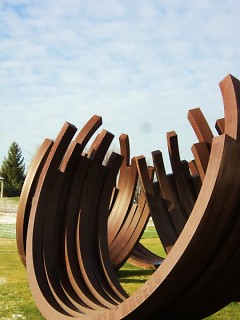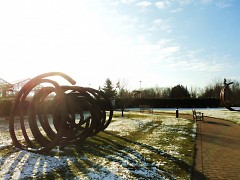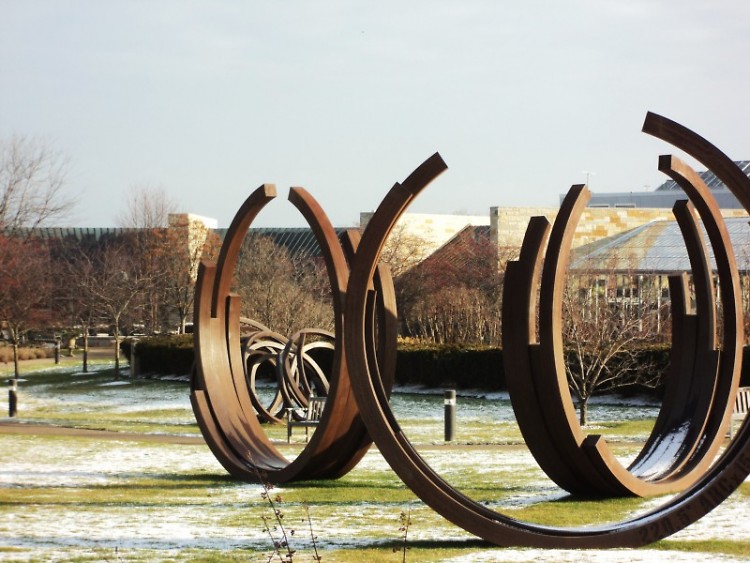For the next ten months Frederik Meijer Gardens is hosting an exhibition of world-renowned German sculpture artist Bernar Venet’s mathematically inspired works. The exhibit was launched in October of this year and will remain open until October, 2013. Five of his steel sculptures have been placed on the front lawn by the entrance, as a complement to “Two Indeterminate Lines,” the Venet piece already in the Meijer Gardens permanent collection.
The pieces in the exhibition are unified and present a consistent sample of Venet’s work. His use of rolled and core-ten steel to experiment with the limits of what geometrical lines and shapes results in work that is surprisingly fluid and heavily influenced by its surroundings.
One of the striking things about the installation is the impact natural light has on the work. It actually changes the emphasis of the pieces with each passing minute. The shadows the pieces cast will lengthen or shorten depending on the time of day and the quality of the natural light shining on them. This in turn changes how dramatic the pieces in the exhibit’s overall impact will be at any given time.
On days with heavier cloud cover the sculptures no longer appear to shift with the passing of time. Their structure seems to become less easily influenced and more definite.
The changing seasons will also alter the work, which is something both Joe Becherer, (The Meijer Gardens’ Chief Curator) and the artist eagerly anticipate.
“One of the things that we're looking forward to is how they change during the seasons," Becherer says of the exhibition. “That's one of the great things about placing things out of doors."
The current plan is for Becherer to send Venet a photo once we finally get a decent snow this season.
The other striking thing about the exhibition has to be the scale of the work. The bulk of the pieces in the exhibit towered over me as I wandered among them. The work was transported to Meijer Gardens in four semi-trucks, and the installation required the use of cranes and hilo lifts. But the size and heft of the sculptures is mostly offset by that fact that most of them form arcs or spirals, which lends another aspect of apparent fluidity and lightness to the work.
"They have geometry as their basis,” Becherer explains. ”And logic and architecture also have that basis."
Despite their very individualistic and pronounced presence, Venet’s sculptures still manage to complement and harmonize with the space they occupy at Meijer Gardens.
“One of the things I like about that space is that there is, depending on your point of view, a relationship to architecture, a relationship to gardens or depending on [the] angles a very important relationship to the sky,” says Becherer.
The Venet exhibition demonstrates each of the relationships Becherer mentions in challenging, but still very enjoyable ways.
Becherer says he believes having the Bernar Venet exhibit will help create a lasting experience and relationship with Venet’s art for the viewer.
“Those pieces [will eventually] have to go away, but we'll still have our piece here,” says Becherer. “It's a healthy and I think nurturing experience to have something bigger [and] broader, and then have your own.”
Becherer says he believes this to be true of all the larger exhibits Meijer Gardens hosts.
“So many people will have an experience at Meijer Gardens where somebody from this area goes someplace else and they see something [they recognize],” he says. “It really does encourage a kind of global awareness and conversation about the visual arts, and it's great that Meijer Gardens can play a role."
The Rapidian, a program of the 501(c)3 nonprofit Community Media Center, relies on the community’s support to help cover the cost of training reporters and publishing content.
We need your help.
If each of our readers and content creators who values this community platform help support its creation and maintenance, The Rapidian can continue to educate and facilitate a conversation around issues for years to come.
Please support The Rapidian and make a contribution today.



